Interior doors of the production of Russia, Spain, Italy and Finland. Features of the design and installation. Price groups.
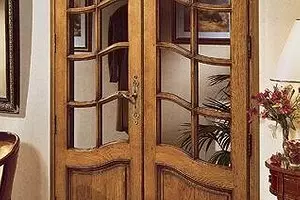
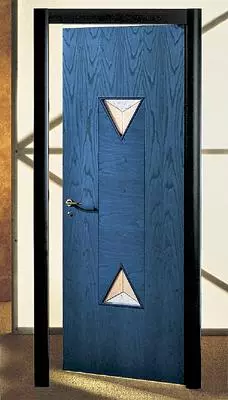
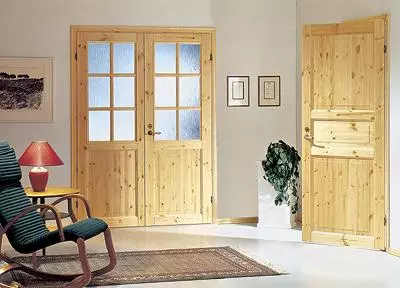
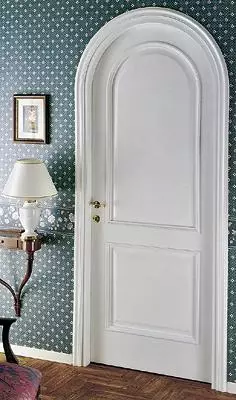
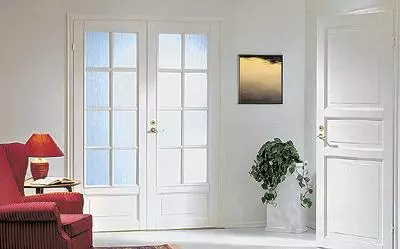
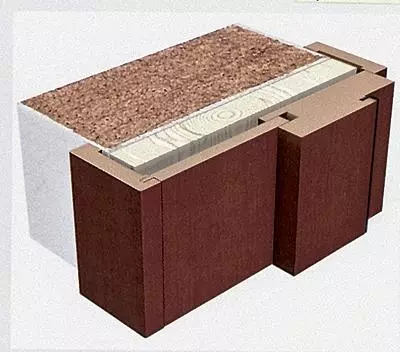
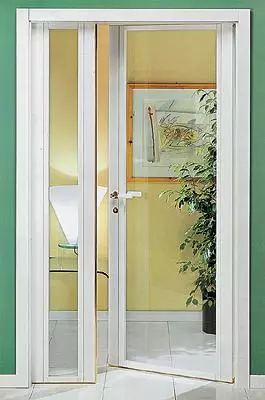
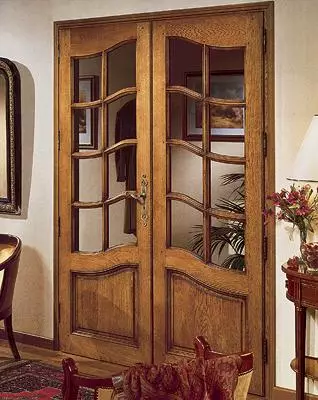
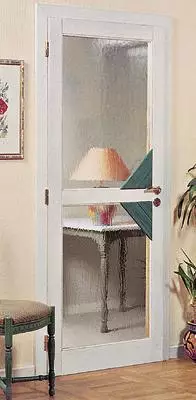
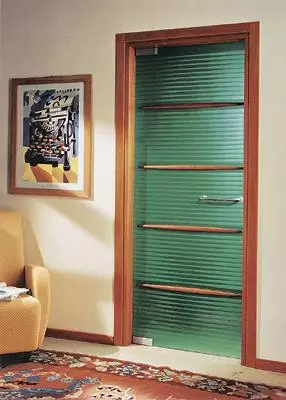
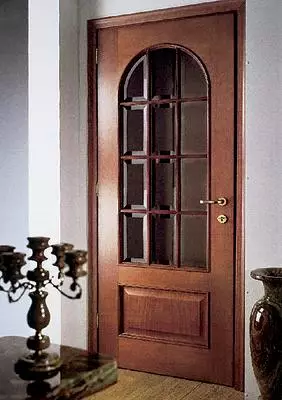
Today in the domestic market you can find doors performed in almost any style. Ito, of course, pleases. However, before making extravagant design decisions, it makes sense to get acquainted with the features of the design and the installation of the products you are interested in. Otherwise, you risk spending a lot of time and money, adapting them to typical openings.
For convenience, we divide the doors offered by the market to producers. Despite the large number of models manufactured in one country, they are all close in design.
Finnish doors
Our fame and the "Massiness" of our Finnish firms acquired primarily due to the snow-white models of laconic design. The most disclosed is the so-called lightweight doors. They are assembled on a frame of a pine beam with a thickness of about 20mm with cellular cardboard filling. A 3-4-millimeter MDF sheet passed on this frame (reminds familiar an organity). The door is covered with white paint, forming a surprisingly smooth and durable layer on the surface (automotive technology). True, it should be noted that with time the paint can acquire the shade of ivory. In addition, any coating, no matter how hard it is, is not guaranteed from scratches and chips. Restore such damage at home is difficult, motorists know how many problems are created even a small flaw on the painted body. In addition to lightweight models, the wholeboo (Wirebo) are manufactured, in which the cardboard is replaced with a pine array. Products are equipped with a reliable abloy mechanism and a collapsible box of a solid pine timber with a shut-off strip and loop.All Finnish products are the doors with a quarter (entrance) equipped with appropriate accessories (except for the handles). The doors of smooth and violent (hidden and arched chicken) are produced. Smooth models worth from $ 60 to $ 100 can be attributed to the economy class, and the pilient and lightweight - consumer price group (their cost is $ 150-250). Somewhat more expensive ($ 200-300) wholesale models.
The advantages of Finnish doors include the fact that they require the minimum setting of the installer, since the loops, the castle and its shut-off strip are already embedded in place. Even the holes for screws are even made in Korobka, and the white plugs are included in the kit. The door box itself is wide (9cm) and powerful, ideal for our walls. After all, the thickness of the typical interior partition is 7.5-8cm, and the extra centimeter allows you to neutralize its possible skews. The rigidity of the box eliminates the likelihood of its deformation, the main reason for which is usually the use of mounting foam.
For elite doors, the issue of adaptation under the existing opening does not usually occur, since their high price makes quite justified redevelopment (up to the construction of new walls). But for the doors of the average price level, and especially cheap, this problem is relevant. You can solve it in two ways. First- choose a door with a height of 190cm (such models are on sale, they produce many domestic enterprises, as well as the Spaniards and Finns followed by our market). The second option is to shorten the door itself.
Height of the Finnish door block - 210cm. The opening, designed in our apartments, often turns out to be less (Russian standards provide for a height of 205cm). Therefore, when installing, some problems may arise. They turn out to be insignificant if the wall is made of soft material (plaster), but noticeable if she is concrete. Here you have to or trim the door itself (a acarkasy design allows you to do this), or drop concrete, which is expensive, and noisy, and dusty. If the wall thickness of several centimeters exceeds the width of the box, as a "challenger", or the "expander" (the terminology of sellers and door installers), you can use a flat platband of the same color.
Appearing in our market back in 1992-1993, the Finnish doors looked very advantageous against the backdrop of non-pieces of domestic products. As the geography of suppliers expands, this advantage is noticeably smooth. But over the past time, Finnish manufacturers (Alavus, Kilsgaard, Matti-Ovi, etc.) have acquired a steady reputation and today retain a small segment of the Russian market.
Spanish doors
Business card of Spanish firms (Proma, Jher, Portadeza, Visel, Uniarte, etc.) - Doors decorated with a glass of mahogany. This material, quite rarely used in Soviet times, in the consciousness of our customers is firmly associated with luxury and high social status. Probably, therefore, Spanish doors still enjoy such success (by the way, quite well-deserved). WHATS The same peak of their popularity in our market fell on the ending period.
Doors etienpical product of modern technologies. The use of the press and a thin-sheet veneer (0.6-0.8 mm) allows you to form from relatively inexpensive materials (MDF and chipboard), and then veneering very complex surfaces, for example, the "volumetric" sealer. As a result, with a few simple operations, it is possible to achieve high quality finishes. Previously, something like that could be obtained only very difficult and only on a solid array. Today, lovers are publicly inexpensive ($ 200-400) combined doors from chipboard and MDF with a frame of natural wood and a veneer trim. The surface of the finished product is covered with several (3-4) layers of varnish. Externally, such doors are not inferior to the most expensive models from an array cost under $ 1000. However, it should be noted that the thin layer of the veneer requires accurate circulation. Spanish firms (for example, Artevi) produce elite doors (worth $ 400-600) of a similar design, and Luyipol- Products from a natural wood array covered with a double layer of veneer.
As a rule, Spanish doors are equipped with a mdf box covered with veneer. Box thick 20mm, width 80mm. Extractive models it has a slot for the supplied rubber seal. In general, the Spanish door boxes, in contrast to Finnish, clearly lack hardness. Therefore, when installing "nannies", especially if an insufficiently qualified specialist is taken for business, there are no cases of deformation. As a result, the door canvas begins to hurt a box that very soon leads to damage to the surfaces. Aynogogo door ceases to close.
The main postulate of the European repair: doors in the entire apartment, including in the bathroom and the toilet, should be the same. But in modern panel construction, the plumbing cabin places in the apartment with a single block and has its own walls and gender. Partitions in such a bathroom are quite thin (4-5cm), so when choosing doors, pay special attention to the width of the box. It should exceed the wall thickness of no more than 1-1.5 cm (taking into account the thickness of the tile and the solution to which it is laid). In the current case, so as not to build up the wall, you can cut off the excess centimeters from the box. It often has to do with boxes of Finnish doors. Note that it is hardly possible to paint the surface with which extra centimeters have been removed. For the same reason, you should not cut the veneer boxes.
The floor in the bathroom, in case the case is not so rare in our conditions of accidents, is equipped with a small boost, a somewhat protected apartment from flooding. Therefore, if you do not take a major redevelopment, the bathroom doors have to be set above (about 10 cm) than the rest. If you mount the standard door at this level, its upper edge will be on the same 10cm higher than that of the rest. As a study nearby, entering the kitchen will emphasize this multi-levelness. Some apartments do not bother this, for others it is of fundamental importance.
Practically in all firms selling Spanish goods, you can buy a "fast bar" from MDF 70mm width and a thickness of 10mm (or 9020mm), covered with a veneer of the same color as the door. This element will allow you to expand the door frame, for which I received one of my names- "Extender".
Along with models with a veneer of mahogany, Spanish manufacturers offer doors lined with oak veneer (light or sealed) and beech, as well as purely white, from painted MDF. All of them are 10-20% more expensive than similar products under the red tree. Cheaper doors are also produced ($ 140-230) - smooth, lightweight, with cellular cardboard filling, according to the construction of similar Finnish.
White Spanish doors face everything along the same automotive technology, and elite models ($ 500) even in several layers, and the coating is not yellowing. But because of the box of MDF, they have one nuance when installed. Aimenno: With manual inserting loops, locks and their locking slats, paint along the edges of the hole sometimes begins to peel. That is, it does not work with a neat, clear boundary between the embedded loop card and the painted surface. Therefore, for installation of doors, if they do not have nests under the loop and locks, it is necessary to attract masters that specialize in mechanical cutting and have a corresponding tool (mill).
Italian doors
Italian doors firmly occupy an elite niche in our market. The price of individual models can reach several thousand dollars, although many manufacturers offer medium price categories. We give a few examples: $ 350-1000 -agoprofil, $ 314-900-Barausse, $ 700-1300- Diemme, $ 800-2500-SJB, $ 400-1500 -ipea, $ 800-1600- donini Nikolini, from $ 850- S. Antonio Group, $ 150-400- WILLE, from $ 600 - Selema. Sadory includes smooth doors, including decorative lining. According to the design, they are usually frame with cellular cardboard filling. Frame and box are glued from a set of bar. There are also models from the massif, beech, pine, trimmed with veneer.Italian doors are both ordinary and a quarter. The latter in combination with the bulk platband do not completely open completely, but are limited to an angle of 130-150. Already mentioned Barausse completes its products with rather original universal loops (however, this principle of the loop device is used by other Italians). They allow fully (at 180) to open the door sash. They are installed on any side of the canvas and require minimal cuts on the upper and, accordingly, its lower end, by the way the least noticeable. However, when using such loops, the gap between the door web and the box (riser) is obtained somewhat large than it is made for interior doors - about5mm.
You can promote only the doors from a solid massif, lightweight frame without filling or with cellular cardboard filling, as well as those whose distance from the edge of the door to the bottom panel is larger than the distance from the top edge to the top panel (after shortening the web, these sizes should turn out to be approximately the same). Usually scolded part of the door below, thereby placing the location of the cut in the least noticeable location.
Italian models supplied to us differ in height of the canvases (200-210 cm) and the width of the door frames (8-12cm). The width of the opening, as a rule, fits into our standards. However, it matters only for relatively cheap doors - from $ 180 to $ 400. More expensive models costs for the required expansion of the opening do not exceed a few percent of the cost of the door itself.
It is believed that in Europe, the leading positions in the manufacture of doors belong to the Italians. Even a superficial look at their products suggests the validity of this opinion. The courage of designer and structural solutions together with a subtle taste is quite obvious. Glass (transparent, matte, color), and not only in the form of inserts, but also as the main element of the door canvase. Kslov say, in the delivery of high-quality glass doors of Italians in our country, German manufacturers have recently launched, for example, Mama (price from $ 490).
But back to the Italians. It is impossible not to note the originality of the structures proposed by Longhi and Rimadesio: the box and frame of the doors are made of ... aluminum and covered with veneer of valuable wood. Agoprofil exposes its three-layer products. Many manufacturers offer to order different decoration of the parties of the doorway (Double-Face). For example, one side of the door facing the bathroom or nursery can be made bright, and the other, looking into the corridor, cove your dark veneer.
Italian doors are not just a color stain in the interior, they actually form it and are one of the dominant space. Making a purchase is better together with the designer, after a solid reflection on the project of the apartment.
Russian doors
If before 17Avgust of 1998, each second sold door sold in our country was Spanish, then the crisis forced buyers to pay attention to Russian goods. It was drawn up that in 5-6 years in domestic production there were striking changes for the better. Outwardly, new Russian doors sometimes did not differ from European, and the price was almost twice the sharply incredible import. Over the past years, prices for domestic products have grown somewhat, but still she feels confidently in their hometown. Moreover, in all price categories, even that is especially nice, in the most elite, where the quality of the goods is coming to the fore. Such an impressive result of domestic producers has become possible due to the combination of modern technologies with good knowledge of the needs of its own market. The elite Russian-Italian furniture series "Elite", the products of the Krasnoyarsk company "Mekran" and Novgorod "Volkhovets" were taken into account.
And yet, despite the obvious of our successes, poor-quality products are enough. Among imports, marriage appears mainly due to violation of the conditions for transportation or storage. The design of products itself practically eliminates such unpleasant things as the warning due to changes in temperature or humidity. Avota in domestic doors marriage can be laid in manufacturing. After all, along with conscientious manufacturers, there are still many those who use simplified technologies to reduce the cost of production. Therefore, when buying Russian doors, you have to be attentive to choose a really good product. Especially since the door made technologically competently, is as much as a frank marriage.
Some of the company tradling by Spanish doors are taken at the expense of the Customer sawing a piece from the combined Spanish doors. It turns out that due to the removal of the lower binder bar weakened the whole design. Sellers usually argue that it is not scary. But it is still better not to carry out similar experiments and trust the manufacturer. Especially since there are ready-made models with a height of 190cm. Our advice: Look for a more responsible seller.
Domestic doors are manufactured mainly from the pine array. They did not breed and did not crack, they make them made of the so-called set of array glued from the bars width not more than 50-60mm. The workpiece for the door is collected from the calculation so that the direction of fibers in the bars alternate. Typically, the bars are connected "to a smooth fugu" ("Mekran"), that is, glue them in the thunder (smooth) surfaces. Valit series from "Elite" This connection is even more firmly, since the bars are connected "on the toothed spike".
Despite the fact that a pine-enough soft tree, the doors from its massif use in the domestic market in great demand. Belongs mainly to the average price group ($ 200-400). Certificate advantages include environmental purity. Some doors (for example, Mekran) are made from Angarsk pine, which has a slightly denser structure and fewer bitch.
Bitch is a separate topic in the production of wood products. For a pine array, their number and view have an important meaning. The bitches should not be through and exceed certain limits both in size (1-2cm) and by number. For door frames, the presence of large through bitch is even more dangerous than for the canvas. The box with a large bitch must be sure to stresses arising in it during installation, so great that no mounting foam and even screws are able to prevent deformation. Therefore, the perfect option when the box is glued, like the array of the door canvase, from the bars "on a smooth fugu" or "on the toothed spike".
From whether a veneer door from a set array was made or not depends, it will lead it or not and will crack its coating. You can see the material only on the end of the door canvase from above or below (these places are usually not closed with veneer).
The quality of the surface also depends on the technology used. Elite doors ($ 500-700) are usually phane in two layers, and in different directions, across and along ("elite"). This method practically eliminates the cracking of the veneer. The cheaper framework of the framework of the framework of MDF sheets or thin plywood with the already glued veneer is usually used for economy class doors ($ 40-150). It is desirable that the surface is covered with several layers of polyurethane varnish.
The doors made on simplified technology, with a violation of the production principles described above, often even when sold, have a curved surface and detached or cracked veneer. Arrangeing their further behavior after installation in place and is completely unpredictable. Therefore, summing up, once again we will remind the principles on the basis of which domestic doors from the array should be chosen:
- Door, and ideally and its box should be made of a set array.
- Throughouts must be drilled and replaced with pasted plugs from the same tree as the main array.
- Large through swirls on the door frame are not allowed.
- Fanroom surface should not have detachments, especially on the ends of the door canvase.
- The door and its details must be proportionate. If it is a violent door or a door with glass, then all straight elements of the fillets or frames must be parallel to the door leaf ends.
- No deviations of the door leaf from the plane are not allowed.
- In cross section, the door must be a rectangle or an equilibried trapezium, but not parallelograms.
- At an inexpensive domestic door ($ 40-80), as a rule, put the appropriate latch-nob. Therefore, that the pen completely lying on the surface of the canvas, and did not hang over the panel, it is necessary that the distance from her end to the edge of the panel is at least 100mm.
Our market there are doors and other Australian, English, American, Indonesian, Polish, German, French, Canadian, Swedish, Baltic ... It seems that this list is almost equal to the list of UN member countries. Nevertheless, about 90% of our market remains for products made in Russia, Spain, Italy and Finland.
The editors thanks the company "Elite" and "Academy of the Interior" for the materials provided.
